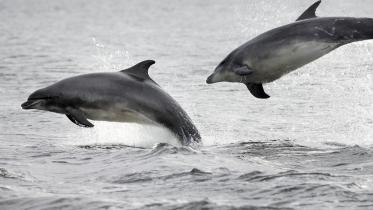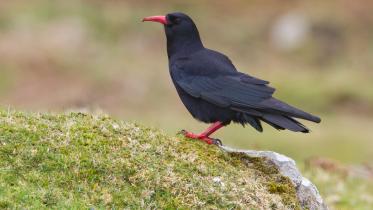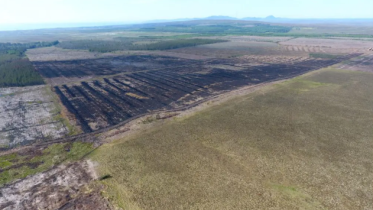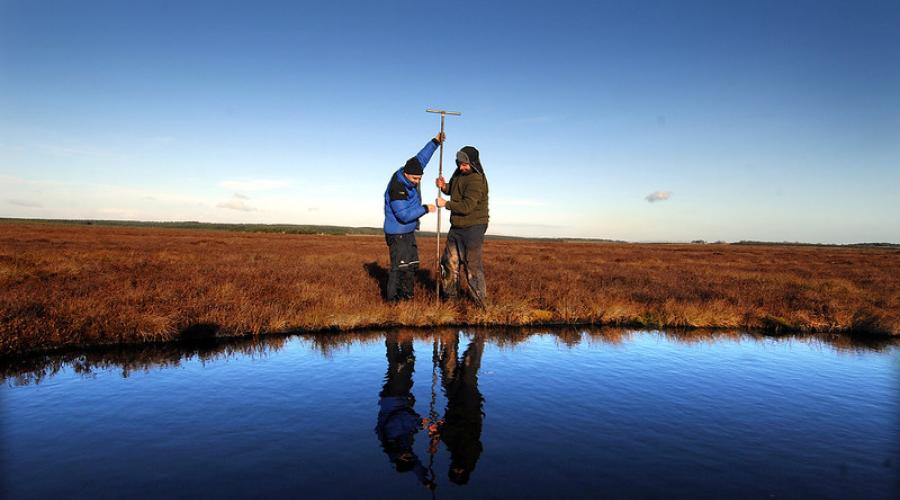
Peatland ACTION - Monitoring strategy
Peatland ACTION Monitoring Strategy 2023-2030
The Peatland ACTION Monitoring Strategy sets out an overall aim and three objectives. These are the guiding principles for all our restoration monitoring including NatureScot Peatland ACTION led monitoring projects, partnership projects and funding of external projects.
Introduction
This introductory section provides an overview of peatland restoration in Scotland and the overall purpose and aim of the Monitoring Strategy, along with a brief on the existing monitoring carried out by Peatland ACTION. The first version of the Monitoring Strategy was written and implemented in 2019 – it has been revised to improve the structure in 2023.
Key messages
- Peatland ACTION is the main mechanism for large-scale publicly funded peatland restoration in Scotland. This is a key solution to the climate-nature crisis and monitoring the work is the priority of this Monitoring Strategy.
- Peatland ACTION requires a structured, strategic approach to our monitoring to ensure and evidence that we are helping meet policy commitments and delivering effective restoration. The Monitoring Strategy was first implemented in 2019 and has been revised to improve the structure in 2023.
- Monitoring categories defined in this document include output monitoring - what are we doing? - and outcome monitoring - is it working? Outcome monitoring is the primary focus of the document.
The overall aim of the Monitoring Strategy is to assess and improve the effectiveness of Peatland ACTION’s peatland restoration. There are three objectives.
Objective A:
Establish if the restoration works are resulting in conditions favourable to the recovery of a functioning peatland habitat. To achieve this, NatureScot Peatland ACTION will:
- Continue to deploy hydrological monitoring on restoration sites.
- Establish a Restoration Monitoring Network for, cost-effective, repeatable, long-term monitoring at a subset of Peatland ACTION sites.
- Support the development and practical implementation of remote sensing / Earth observation tools to enable large-scale monitoring.
Objective B:
Establish the effectiveness of individual techniques in specific settings. To achieve this, NatureScot Peatland ACTION will:
- Establish monitoring projects to further the knowledge of peatland restoration techniques.
- Support applicants to monitor their own novel restoration techniques where appropriate.
- Disseminate lessons learnt across the Peatland ACTION delivery partners.
Objective C:
Collate, summarise and contribute to the evidence base associated with the ecosystem services of peatlands. To achieve this, NatureScot Peatland ACTION will:
- Communicate relevant research developments across Peatland ACTION.
- Coordinate monitoring support and investment with RESAS and the Scientific and Technical Advisory Group (STAG).
- Support peatland research that contributes to the key topics and evidence listed in this document.
We use multiple pathways to achieve the overall aim and three objectives including NatureScot Peatland ACTION monitoring, partnership projects and funding of external projects. This document also outlines and tracks progress of current and past monitoring projects. There will be a regular review of this Monitoring Strategy to ensure it remains current and accurate.
The overall purpose of the Monitoring Strategy
“Peatland ACTION requires a structured, strategic approach to ensure and evidence that we are helping meet policy commitments and delivering effective restoration.”
Policy context
The value of protecting and restoring peatlands in Scotland is recognised in several key documents and government policy. In 2015, Scotland’s National Peatland Plan had an overall vision to encourage "a new focus on positive management, supported by evidence and research, so that these landscapes are revived and healthy - not just in protected areas, but throughout the country". The Scottish Government has committed to restoring 250,000 hectares of degraded peatland by 2030 with total funding of £250 million, as set out in the Climate Change Plan 2018–2032 and the Infrastructure Investment Plan for Scotland. This urgency reflects the Scottish Government’s declaration of a climate emergency with plans to reach net zero by 2045. In addition, peatland restoration will be integral to the approach of the Scottish Biodiversity Strategy delivery plans, which intends to bring biodiversity and climate change directly in line and significantly contribute to tackling the twin crises ensuring a nature-rich future for all.
Peatland restoration mechanisms
Peatland restoration in Scotland is achieved through a number of mechanisms besides Peatland ACTION, which is a support mechanism and associated fund for landowners and land managers to enable practical on-the-ground peatland restoration. Other mechanisms are:
- Agri-Environment Climate Scheme: a fund to promote land management practices that protect and enhance Scotland’s natural heritage, improve water quality, manage flood risk and mitigate and adapt to climate change.
- National Planning Framework 4 intends to:
- Protect carbon-rich soils, restore peatlands and minimise disturbance to soils from development (Policy 5).
- Protect biodiversity, reverse biodiversity loss, deliver positive effects from development and strengthen nature networks (Policy 3).
- Protect, restore and enhance natural assets making best use of nature-based solutions (Policy 4).
- Peatland Code: a voluntary certification standard for UK peatland projects wishing to market the climate benefits of peatland restoration.
- Private and environmental non-governmental organisation (NGO) green enterprise: an increasing number of private landowners and NGOs are interested in supporting peatland restoration, motivated by a wide range of factors.
Peatland ACTION
Peatland ACTION is a national programme to restore peatlands across Scotland. It is led and funded by Scottish Government and delivered in partnership with NatureScot & supporting agents: the National Park Authorities (Cairngorms and Loch Lomond and the Trossachs), Scottish Water, and Forestry and Land Scotland. Between 2012 and 2023, we have put over 43,000 hectares of degraded peatland on the road to recovery, but this effort needs to accelerate rapidly in the coming years to help address the twin crises of the climate emergency and biodiversity loss. Peatland ACTION contributes to the development of land use policy and technical guidance where appropriate. We also collaborate with the Rural and Environment Science and Analytical Services Division (RESAS) to support their wide range of analytical projects and commissioned research on peatlands.
Peatland ACTION monitoring categories
Output monitoring: what we are doing?
Outcome monitoring: is it working?
Peatland ACTION requires a structured, strategic approach to ensure and evidence that we are helping meet policy commitments and delivering effective restoration. Monitoring is a word used in a range of contexts, for instance, restoration projects within Peatland ACTION are also subject to compliance monitoring associated with the agreed conditions of grant funding and completion of works. This Monitoring Strategy does not cover all types of monitoring, rather it focuses on two categories of monitoring associated with peatland restoration:
- Output monitoring: what are we doing? This measures indicators that reflect the implementation of peatland restoration activities.
- Outcome monitoring: is it working? This measures indicators that represent the objectives of peatland restoration, i.e. the effectiveness of the implemented restoration activities.
Output monitoring is vital to track progress of restoration projects, while outcome monitoring assesses the long-term effectiveness of the restoration work. Our output monitoring is outlined in brief below. Outcome monitoring is the focus of this Monitoring Strategy and is essential to assess and refine the restoration of peatlands. Monitoring outcomes is also important to inform good use of public money and communicate results to stakeholders and the public.
Peatland ACTION output monitoring
Peatland ACTION’s output monitoring involves recording information about each restoration project during the application and final report process, including spatial data about all completed restoration activities. We use this spatial data to report hectares put on the road to recovery to the Scottish Government, and NatureScot lead on the verification of hectares for all delivery partners. This supports the monitoring and reporting requirements of the Climate Change Plan 2018–2032 . We have developed specific guidance that details this standardised process.
Spatial data from our restoration projects is also used to report associated Greenhouse Gas (GHG) emission reductions for the UK GHG Inventory. Reporting peatland emissions for the UK GHG Inventory is an example of taking an output-based indicator (area of peatland restored) and converting it into an outcome-based indicator (estimated GHG emissions) using a standardised methodology developed using empirical data. Simple metrics for reporting the estimated impact of restoration on other benefits like biodiversity are not currently available, but we will move towards reporting other outcomes in a similar manner when equivalent methodologies are developed.
Outcome monitoring is covered in the following sections, with details of previous or ongoing monitoring projects provided in Annex 1. Early monitoring projects that preceded the Strategy were appropriate for a smaller scale project and have been continued where appropriate. The scope and targets of peatland restoration through Peatland ACTION have continued to expand rapidly, so we have needed to review and redevelop our monitoring over time.
Aim of the Monitoring Strategy
Our high-level strategic approach to monitoring has an overall aim and three objectives (Figure 1). The overall aim is to assess and improve the effectiveness of Peatland ACTION’s peatland restoration. A significant focus of monitoring will be on assessing effectiveness in terms of peatland hydrology and ecology (Objectives A and B, Figure 1).
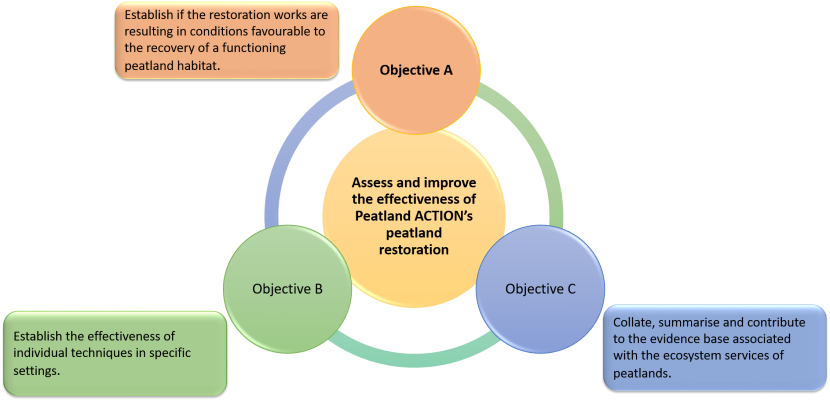
Figure 1 illustrates the Monitoring Strategy’s overall aim, which is to assess and improve the effectiveness of Peatland ACTION’s peatland restoration, along with the three objectives:
- Objective A - Establish if the restoration works are resulting in conditions favourable to the recovery of a functioning peatland habitat.
- Objective B - Establish the effectiveness of individual techniques in specific settings.
- Objective C - Collate, summarise and contribute to the evidence base associated with the ecosystem services of peatlands.
Implementation, review and communication
This Monitoring Strategy sets out the aim and objectives (what we want to achieve) that are the guiding principles for our decision making around outcome monitoring. The method for achieving these objectives is more flexible. This allows Peatland ACTION to take advantage of future opportunities, such as the development of monitoring techniques using Earth observation (EO) and unoccupied aerial vehicles (UAVs). We use multiple pathways to achieve the aim and objectives including NatureScot Peatland ACTION monitoring, partnership projects and funding of external projects. The outcome monitoring budget will be subject to annual review to ensure adequate funds are available to meet the requirements of our objectives.
We will make the results of monitoring and associated datasets publicly available wherever possible to support research and the implementation of effective restoration across the UK and beyond. Sensitive information or temporary data embargos to allow researchers to work-up data for publication occasionally prevent the immediate release of datasets into the public domain. Sharing key outputs with the public and Scottish Government will also be important to raise understanding of the benefits of peatland restoration. A regular review of the Monitoring Strategy will ensure it remains current and accurate.
Objectives
The overall aim is broken down into three main objectives. Objective A looks at overall restoration effectiveness, Objective B focuses on specific techniques and settings, and Objective C looks at the wider benefits of peatland restoration. Active monitoring projects relevant to each objective that are being supported or led by NatureScot are provided in Figure 2, Figure 3 and Figure 4. Further project details, updates and plans are provided in Annex 1.
Objective A: Establish if the restoration works are resulting in conditions favourable to the recovery of a functioning peatland habitat.
NatureScot Peatland ACTION will:
- Continue to deploy hydrological monitoring on restoration sites.
- Establish a Restoration Monitoring Network for cost-effective, repeatable, long-term monitoring at a subset of Peatland ACTION sites.
- Support the development and practical implementation of remote sensing / Earth observation tools to enable large-scale monitoring.
Rationale
Full recovery to a stable, functioning peatland takes decades and may not be possible for heavily degraded sites. In addition, the complexity of peatland systems, historical management impacts and innovative approaches to restoration means that measuring ‘success’ of restoration activities is a difficult task. A degraded peatland may never return to the structure and functions of the original ecosystem, but partial restoration may restore ecosystem functioning to an adequate level to provide certain ecosystem services. In light of this, Peatland ACTION’s view of success is that restoration works set peatlands ‘on the road to recovery’.
Monitoring will capture changes in condition that indicate restoration works have initiated a change in peatland state that will encourage the re-establishment of some ecosystem functions. At the very least, and in the first instance, restoration will seek to prevent further degradation. Several parameters could be measured that would be expected to be altered through restoration including fluctuation of annual water table level, percentage Sphagnum cover, presence of positive and negative indicator species, and change in the extent of bare peat.
Key questions and outcomes
- A1: What are the impacts of restoration activities upon indicators of peatland condition such as the water table, vegetation indicators, Sphagnum cover and bare peat?
- Outcome sought: Evidence of hydrological, ecological and physical changes on degraded peatlands post-restoration.
Active projects
Figure 2 provides an overview of the active monitoring projects which are contributing to Objective A.
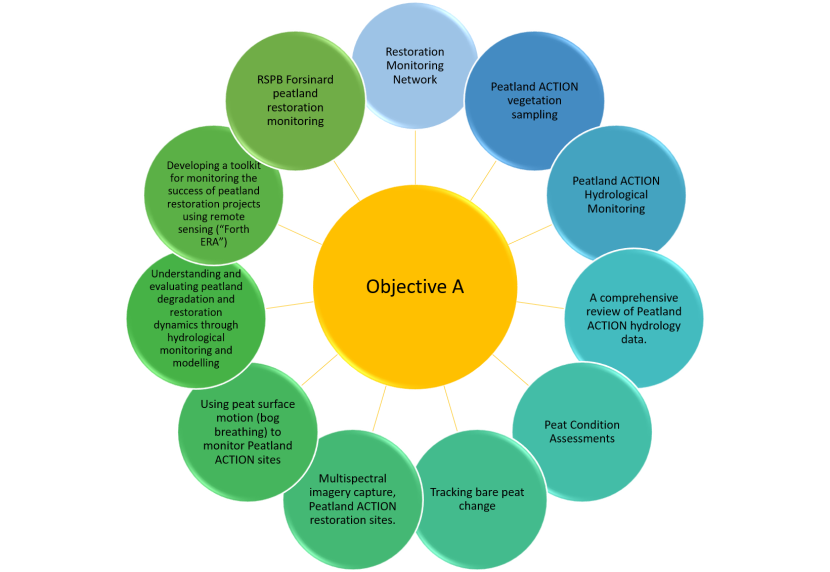
Figure 2 illustrates the active monitoring projects associated with achieving Objective A that are supported or led by NatureScot. These include:
- Restoration Monitoring Network.
- Peatland ACTION vegetation sampling.
- Peatland ACTION hydrological monitoring.
- A comprehensive review of Peatland ACTION hydrology data.
- Peat Condition Assessments.
- Tracking bare peat change.
- Multispectral imagery capture, Peatland ACTION restoration sites.
- Using peat surface motion (bog breathing) to monitoring Peatland ACTION sites.
- Understanding and evaluationg peatland degradation and restoration dynamics through hydrological monitoring and modelling.
- Developing a toolkit for monitoring the success of peatland restoration projects using remote sensing (“Forth ERA”).
- RSPB Forsinard peatland restoration monitoring.
Objective B: Establish the effectiveness of individual techniques in specific settings
• Establish monitoring projects to further the knowledge of peatland restoration techniques.
• Support applicants to monitor their own novel restoration techniques where appropriate.
• Disseminate lessons learnt across the Peatland ACTION delivery partners
Rationale
Investigating restoration techniques in specific settings will help inform future selection of restoration activities and drive more efficient, cost-effective interventions. Peatland ACTION’s Technical Compendium describes best practice for peatland restoration techniques based on our shared experience of restoration application and outcomes. We need to build on this knowledge and so monitoring the effectiveness of these techniques is critical. We will develop a programme to monitor the success of the techniques, with a focus on the more technically difficult or novel approaches.
Active projects
Figure 3 provides an overview of the active monitoring projects which are contributing to Objective B
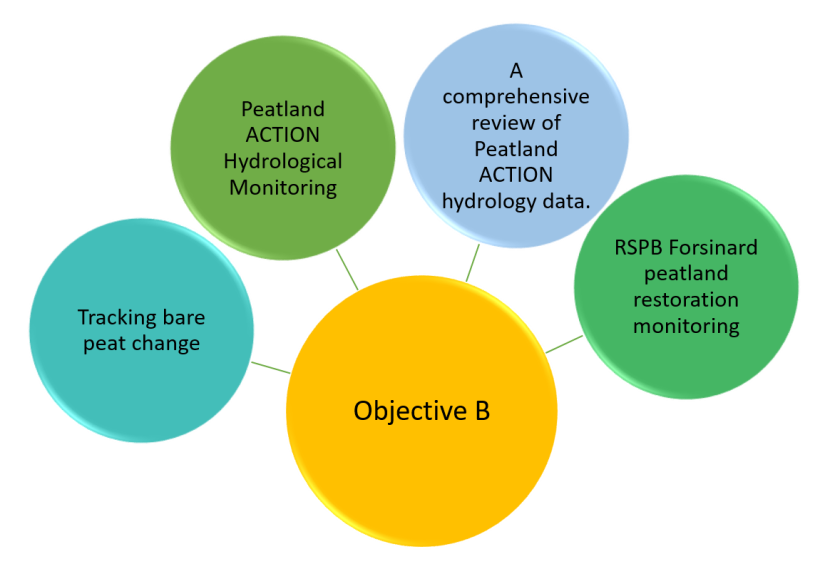
Figure 3 illustrates the active monitoring projects associated with achieving Objective B that are supported or led by NatureScot which include:
- A comprehensive review of Peatland ACTION hydrology data.
- RSPB Forsinard peatland restoration monitoring.
- Tracking bare peat change.
- Peatland ACTION hydrological monitoring.
Objective C: Collate, summarise and contribute to the evidence base associated with the ecosystem services of peatlands
NatureScot Peatland ACTION will:
- Communicate relevant research developments across Peatland ACTION.
- Coordinate monitoring support and investment with RESAS and the Scientific and Technical Advisory Group (STAG).
- Support peatland research that contributes to the key topics and evidence listed in this document.
Rationale
There is much research on peatlands and peatland restoration in Scotland and internationally. We will follow developments and ensure results are communicated across Peatland ACTION to increase awareness and inform adoption of best practice techniques. Research into the multiple benefits of peatland restoration often requires considerable expertise or expensive, intensive monitoring. We will support research into these co-benefits through collaborations and funding as well as helping trial the application of new techniques. This will help improve the evidence base associated with peatland restoration and the development of standard methodologies for monitoring and reporting benefits.
Support for peatland research will be coordinated with RESAS and the Scientific and Technical Advisory Group (STAG) to ensure efficient use of resources. We will also continue to collaborate with universities, research institutes, NGOs and other agencies to identify evidence gaps and help direct our input to external research and monitoring. Monitoring and research supported by Peatland ACTION must include sites where we have funded or anticipate funding on-the-ground peatland restoration activities. We are developing guidance and associated documentation for external requests for monitoring funding which we will launch by 2025. The broad key topics associated with Objective C are listed below.
Key topics and evidence gaps
- C1: Water quality – the effect of peatland restoration on downstream water quality and resulting impacts on public drinking water or the ecological status of water bodies.
- C2: Water quantity and flood alleviation – the effect of peatland restoration on regulating water flow within catchments and resulting benefits in terms of natural flood management.
- C3: Fire risk control – the ability of peatland restoration to reduce wildfire risk and the management of risk on degraded sites.
- C4: Biodiversity – the effect of peatland restoration on biodiversity and the development of key indicators to measure peatland biodiversity.
- C5: Social and economic outcomes – the role of Peatland ACTION in supporting rural jobs and skills development; the social and economic benefits resulting from restored peatlands.
- C6: Greenhouse gas (GHG) storage and sequestration – the effect of restoration in reducing GHG emissions from degraded peatlands and supporting long-term carbon sequestration.
Active projects
Figure 4 provides an overview of the active monitoring projects which are contributing to Objective C
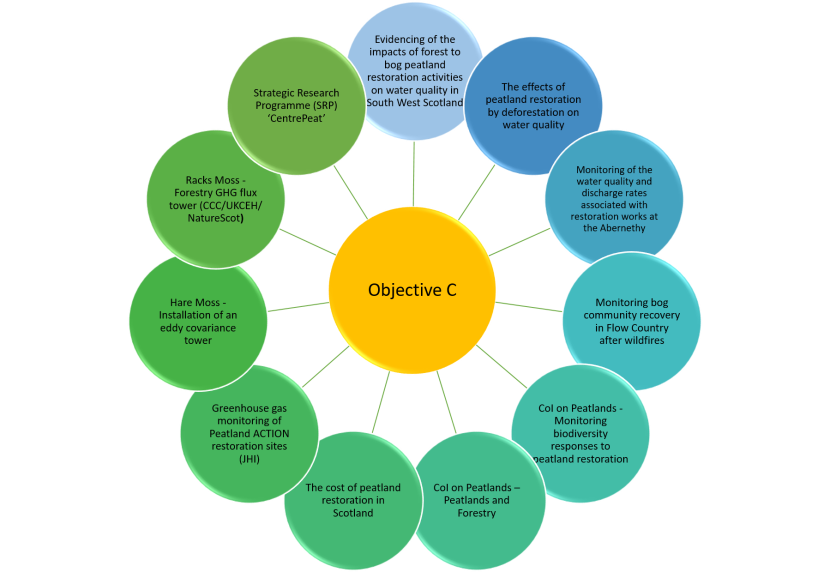
Figure 4 illustrates the active monitoring projects associated with achieving Objective C that are supported or led by NatureScot these include:
- Evidencing of the impacts of forest to bog peatland restoration activities on water quality in South West Scotland.
- The effects of peatland restoration by deforestation on water quality.
- Monitoring of the water quality and discharge rates associated with restoration works at the Abernethy.
- Monitoring bog community recovery in Flow Country after wildfires.
- CoI on Peatlands - Monitoring biodiversity responses to peatland restoration.
- CoI on Peatlands – Peatlands and Forestry.
- The cost of peatland restoration in Scotland.
- Greenhouse gas monitoring of Peatland ACTION restoration sites (JHI).
- Hare Moss - Installation of an eddy covariance tower.
- Racks Moss - Forestry GHG flux tower (CCC/UKCEH/NatureScot).
- Strategic Research Programme (SRP) ‘CentrePeat’.
Annexes
Annex 1: Monitoring Strategy project updates
We will update this section regularly with details of monitoring we have started, continued or completed. In addition, actions for the coming financial year are outlined. References to any technical reporting or interpretation of results will be provided. A map of the spread of NatureScot Peatland ACTION monitoring projects is shown in Figure 5.
2021 - 2023
- We completed a draft document outlining plans to develop the Restoration Monitoring Network. We gathered internal and external feedback on the plans and have piloted the methods on a range of sites. The feedback and pilot season have informed the development of a revised document produced and refined in 2023/24. We aim to start monitoring the first suite of sites in summer 2023.
- Repeat vegetation surveys were completed at 13 sites that had baseline surveys in 2014/15. The resulting reports (2014/15 surveys, 2021 surveys) have been published alongside the datasets. The findings will also contribute to future monitoring within the Restoration Monitoring Network.
- Maintenance of the existing Peatland ACTION hydrological monitoring regime to ensure continued operation of the equipment along with a data download for two years of measurements was completed in 2022. In addition, final repairs to the Flanders Moss National Nature Reserve hydrological monitoring equipment were completed. Hydrological monitoring data has been processed and made publicly available. Data has been provided directly to the James Hutton Institute (JHI) for their work on the RESAS Strategic Research Programme (SRP) CentrePeat.
- A comprehensive review of the existing hydrological data collated by Peatland ACTION was commissioned in 2022/23. This will review the response of water table dynamics on the restored sites and will inform effective and efficient ongoing hydrological monitoring as part of the Restoration Monitoring Network.
- The Internet of Things (IoT) hydrological monitoring trial phase led by Scottish Government and implemented by FarrPoint was completed between 2021 and 2023. NatureScot Peatland ACTION formally adopted the equipment in 2023 and continues to run the IoT network to gather baseline data prior to restoration. The loT data is accessible via an online dashboard and the hope is to continue data collection post restoration. This is an opportunity to test a new approach to hydrological monitoring in rural locations.
- A review of high-resolution remote sensing methods to monitor the effectiveness of peatland restoration on actively eroding blanket bogs was commissioned and completed in 2022/23. This includes data captured using UAV, manned aerial vehicles and high-resolution satellites. The review will be published and will be used to assess the applicability of such methods and the potential for integration on a sample of sites within the Restoration Monitoring Network.
- We have produced and published guidance on a common standard for UAV deployment and data products to enable effective use. This is the first step towards more extensive use of UAVs for both the capture of promotional material and in support of monitoring. The guidance is not entirely prescriptive as an adaptive approach is necessary to meet individual project requirements. The guidance provides examples of UAV platforms and sensors, and software for planning and processing.
- Results from 11 focus sites for the ‘bog breathing’ project were published in NatureScot Research Report 1269. This uses Earth observation (EO) measurements of peatland surface motion to assess peatland condition. The report yielded a lot of interest from other environmental agencies and companies, as well as the press. A new technique (Apsis) was applied and increased resolution (30m), which allowed double-blind testing to take place in 2022/23. NatureScot, along with project partners, are looking into upscaling the technique for wider assessment of temporal change of peatland condition across more Peatland ACTION sites.
- We entered an ongoing partnership project with the University of Stirling, which forms the peatlands use-case of the Forth-ERA programme. This project will develop a toolkit for monitoring the success of peatland restoration using remote sensing. It will develop, test and apply methods by combining data from wireless sensor networks and satellite-based remote sensing, using a series of demonstration sites in the Forth catchment. The data will be made available in near real-time through a bespoke web-based platform. The project includes installation of an eddy covariance greenhouse gas flux tower (hereafter called GHG flux towers) at Flanders Moss National Nature Reserve.
- The purchase of four GHG flux towers was funded in 2019/20 in a joint effort with the James Hutton Institute (JHI), UK Centre for Ecology and Hydrology (UKCEH), Crichton Carbon Centre (CCC) and the National Peatland Research and Monitoring Group (NPRMG now replaced by STAG). The aim is to fill some of the knowledge gaps that surround restoration and GHG (carbon dioxide and methane) emissions in Scotland. The delayed installation of the JHI-managed GHG flux towers was completed in 2021/22 and data capture will now be ongoing. We commissioned a technical specification to enable installation of the CCC/UKCEH-managed forestry GHG flux tower, which is now planned for 2023/24. These flux towers form part of the Sco2Flux network of GHG monitoring towers.
- We have funded the installation of an additional GHG flux tower to be operated by UKCEH at a raised bog in Midlothian. This will provide measurements at this site before, during and after restoration, to determine changes in GHG emissions resulting from restoration. This will be further supported by comparison with long-term GHG flux tower data from the nearby UKCEH Auchencorth Moss research facility. This flux tower is affiliated with the Sco2Flux network.
- Support for the long-term monitoring work into forest-to-bog restoration techniques at the Royal Society for the Protection of Birds (RSPB) Forsinard Flows nature reserve was continued.
- Additional equipment and resource were provided to the Galloway Fisheries Trust to continue their water quality monitoring project.
- Scotland’s Rural College (SRUC) continue to process and update the database of peatland restoration costs using Peatland ACTION’s application data.
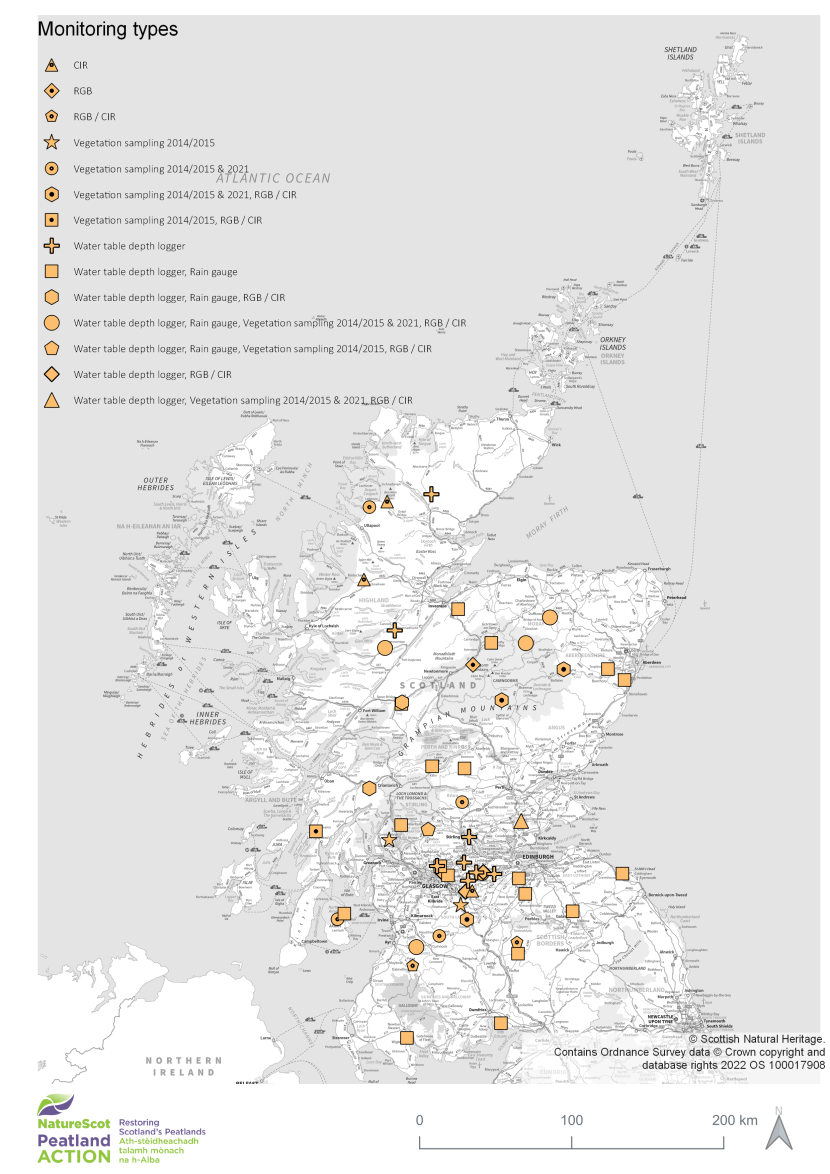
Figure 5 Ordinance Survey map of Scotland showing the locations of NatureScot Peatland ACTION monitoring sites to date.
The monitoring techniques listed on the map include; Colour infrared image capture, Red Green Blue image capture, Colour infrared/Red Green Blue image capture, Vegetation sampling 2014/2015, vegetation sampling 2014/2015 and 2021, water table depth loggers, rain gauges and any combination.
Abbreviations for unoccupied aerial vehicles (UAV) captured imagery: CIR – Colour Infrared, RGB – Red Green Blue.
Peatland ACTION monitoring projects to date
Restoration Monitoring Network (RMN)
Objective:
A - To establish if the restoration works are resulting in conditions favourable to the recovery of a functioning peatland habitat.
Lead organisation:
NatureScot
Project details and progress update
Timescales: Currently in development with the aim of implementation from 2023/24 onwards.
2022/23: The consultation on the draft documentation was undertaken along with a pilot study to refine field protocols.
2021/22: Investigation of the potential study design, sampling approach and methodologies was carried out to begin drafting documentation and field protocols.
2020/21: Work focused on establishing the Peatland ACTION monitoring priorities to provide direction to the development of future NatureScot Peatland ACTION monitoring work.
Peatland ACTION input for 2023/2024
- Finalise documentation.
- Establish governance structure.
- Undertake baseline surveys of the first suite of RMN sites.
Peatland ACTION vegetation sampling
Objective
A - To establish if the restoration works are resulting in conditions favourable to the recovery of a functioning peatland habitat.
Lead Organisation
NatureScot
Timescale: Data capture complete. Reports published in 2022/23.
2021/22: In the summer of 2021 repeat vegetation surveys were completed on 13 sites at which baseline surveys had been undertaken in 2014/15. This dataset and the subsequent report will help inform the development and implementation of the Restoration Monitoring Network.
2014/15: Vegetation monitoring at 17 sites (Figure 5) was commissioned in 2014/15 to establish site conditions immediately after restoration activities. Pre-restoration baseline monitoring was not possible but some controls (degraded but unrestored sites) and reference (good quality bog considered typical of the area) sites were established.
Peatland ACTION input for 2023/2024
• Use outputs and outcomes to inform Restoration Monitoring Network development.
Peatland ACTION hydrological monitoring
Objective
A - To establish if the restoration works are resulting in conditions favourable to the recovery of a functioning peatland habitat.
B - Establish the effectiveness of individual techniques in specific settings.
Lead organisation
NatureScot
Project details and progress update
Timescale: Ongoing data capture, review of hydrological monitoring design as part of the comprehensive review of Peatland ACTION hydrology data (below).
2022/2023: Sensors connected via an Internet of Things approach were installed at part of a government pilot at a site adjacent to Loch Orasaigh on the Isle of Lewis. This equipment was adopted by NatureScot Peatland ACTION to continue the capture of baseline data through restoration and into the post restoration phase.
2021/22: The maintenance of the existing Peatland ACTION hydrological monitoring regime was carried out to ensure continued operation of the monitoring equipment. No additional hydrological monitoring equipment (e.g. water table depth loggers or rain gauges) was added to the scheme. Final repairs of water level rain gauges at Flanders Moss National Nature Reserve completed. Data from loggers was published online in 2022/2023.
2020/21: Peatland ACTION funded repairs of water level rain gauges at Flanders Moss National Nature Reserve which contribute to a long-term water level monitoring dataset.
2018/19 - 2019/20: The maintenance of the existing Peatland ACTION hydrological monitoring regime was carried out to ensure continued operation of the monitoring equipment. No additional hydrological monitoring equipment (e.g. Water table depth loggers or rain gauges) was added to the scheme. Data from loggers were downloaded and processed.
2014/15 – 2017/18: A scheme of Peatland ACTION managed hydrological monitoring was implemented in 2014, with 127 loggers spread over 38 sites measuring the hourly or half-hourly change in water table depth. The vast majority are telemetry based and the data is received, processed and sent to Peatland ACTION by SEPA under a Memorandum of Agreement. The water table loggers should help determine how the water table has responded to restoration management: the depth to the water table should decrease (become closer to ground level) and stabilise after restoration, resulting in the water table staying within an idealised zone for an increased proportion of the year. Rain gauges have also been installed at 25 sites where existing (publicly available) rainfall gauges are not available in order to provide some meteorological context to the water table data. A significant amount of data has been collected but a detailed review and associated analysis is required.
Peatland ACTION input for 2023 - 2024
- Maintain equipment and download data as appropriate.
- Review hydrological monitoring as part of Peatland ACTION and decide on how to move forward.
A comprehensive review of Peatland ACTION hydrology data
Objective
B - Establish the effectiveness of individual techniques in specific settings
Lead organisation
NatureScot
Project details and progress update
Timescale: Projected completion by start of 2023/24
2022/23: An external review by specialists of the existing hydrological data was commissioned in 2022/23. This will review the response of water table dynamics on the restored sites and include an options appraisal to inform effective and efficient ongoing hydrological monitoring as part of the Restoration Monitoring Network.
2020/21: Analysis of the hydrology data was started by Peatland ACTION in order to inform the future hydrological monitoring.
Peatland ACTION input for 2023 - 2024
- Review options appraisal report for hydrological monitoring as part of Peatland ACTION and decide on how to move forward.
Peat condition assessments
Objective
A - To establish if the restoration works are resulting in conditions favourable to the recovery of a functioning peatland habitat.
Lead organisation
NatureScot
Project details and progress update
Timescale: Ongoing as part of restoration planning
2017/18 – present: Peat condition assessments form part of the peat depth surveys undertaken through Peatland ACTION and follow a standardised approach.
Peatland ACTION input for 2023 - 2024
- Continue to regularly publish as open data.
- Consider including assessment of condition as part of Restoration Monitoring Network.
Multispectral imagery capture, Peatland ACTION restoration sites
Objective
A - To establish if the restoration works are resulting in conditions favourable to the recovery of a functioning peatland habitat.
Lead organisation
NatureScot
Project details and progress update
Timescale: Complete
2015/16: UAVs have been deployed at several Peatland ACTION restoration sites (Figure 5), including 21 sites using multi-spectral imagery (RGB and near Infrared) and two sites using LiDAR. The images were used in a variety of ways, two of which have potential as monitoring techniques. Firstly, semi-automated estimates of bare peat and Sphagnum cover could be used to track change over time on restoration sites. Although promising, more investment is needed, including ground-truthing data collection to improve accuracy. Secondly, digital terrain models, digital surface models and hill shade analysis can identify flow pathways over large areas. Flights before and after restoration could thus monitor change in water flow pathways. One way this could help is to identify areas that need extra work.
Peatland ACTION input for 2023 - 2024
- None – complete.
Tracking bare peat change
Objective
A - To establish if the restoration works are resulting in conditions favourable to the recovery of a functioning peatland habitat.
B - Establish the effectiveness of individual techniques in specific settings.
Lead organisation
NatureScot
Project details and progress update
Timescale: Projected completion by start of 2024/2025
2022/23: A review of high-resolution remote sensing methods to monitor the effectiveness of peatland restoration on actively eroding blanket bogs was commissioned in 2022/23. This includes data captured using UAV, manned aerial vehicles and high-resolution satellites.
2019/20: Use of Sentinel 2 satellite imagery (open data) to develop a technique to identify bare peat extent across Scotland. Sentinel 2 was successfully used to generate a map of bare peat across Scotland. This aims to draw out larger areas of bare peat, as with any semi-automated approach there are limitations (https://erdms.nature.scot/documents/zA206712/details). The Scottish bare peat map viewer allows easy access to the resulting dataset.
Peatland ACTION input for 2023 – 2024
- Publish report on use of high-resolution remote sensing methods on actively eroding blanket bogs.
- Review applicability of methods for integration into the RMN.
Using peat surface motion (bog breathing) to monitor Peatland ACTION sites
Objective
A - To establish if the restoration works are resulting in conditions favourable to the recovery of a functioning peatland habitat.
Lead organisation
Nottingham University
NatureScot
Forest and Land Scotland
University of Highlands and Islands
Project details and progress update
Timescale: We aim to integrate remote sensing monitoring tools into the Restoration Monitoring Network and wider monitoring of peatland restoration by 2024/25.
2022/2023: Validation of peatland condition classification developed in the Flow Country and applied at Bunloit Estate. The NatureScot Research Report 1308 - Analysis of an InSAR ‘bog breathing’ based classification of peatland condition relative field observations in Cairnsmore of Fleet National Nature Reserve’will be published. This report proposes a revised (field) classification fit for upscaling the technique across a wider range of peatland condition sites. Further work is looking at applying an updated peatland condition classification to a wide range of Peatland ACTION sites and applying multi-change analysis across parts of Scotland. Twenty peatland sites were selected for peat slide risks using InSAR-derived peat surface motion dynamics. This work was set up to act as an independent analysis to allow for comparison with the traditional methods used by Peatland ACTION. A report has been produced and will be published.
2021/22: The results from the 11 focus sites were published in the Research Report 1269. This yielded a lot of interest from other environmental agencies and companies, as well as the press. As part of the wrap up of this initial project, another technique (Apsis) was applied and increased resolution (30m) allowed for additional double-blind testing of the method for peatland condition monitoring, which will take place in 2022/2023. NatureScot, along with the partners, are looking into upscaling the technique for wider assessment of temporal change of peatland condition across more, if not all, Peatland ACTION sites. Efforts are being undertaken to start collecting more validation data from the field, potentially in conjuncture with the Restoration Monitoring Network.
2020/21: A total of 11 focus sites were selected for further exploration, which yielded valuable insights into the limitations (research opportunities) and advantages of the technique to link peat surface motion to peatland condition. Along with feedback from the community and internal reviews, the team was asked to write a publication on the outputs. Additional applications (e.g. drought-effect, peat slide risk) are also being explored.
2019/20: Use of Sentinel-1 satellite radar (open data) to develop a technique to monitor peat surface motion across large scales (approximately 100m resolution) using an algorithm developed by Terramotion. Using this ISBAS-InSAR-derived signal, the effects of restoration on peat surface condition were assessed and further explored across a wider range of sites.
Peatland ACTION input for 2023 – 2024
- Support the practical application of the tools developed.
- Publish associated research reports.
Developing a toolkit for monitoring the success of peatland restoration projects using remote sensing (“Forth ERA”)
Objective
A - To establish if the restoration works are resulting in conditions favourable to the recovery of a functioning peatland habitat.
Lead organisation
University of Stirling - Scotland’s International Environment Centre (SIEC)
Project details and progress update
Timescale: Projected completion January 2024
2022/23: The five demonstration sites in the Forth catchment have been identified and sensor installation has commenced. This includes installation of a GHG flux tower at Flanders Moss National Nature Reserve. Work has continued on developing remote sensing methods to measure peatland condition using data from Sentinel-1, Sentinel-2 and MODIS satellites.
2021/22: Eddy covariance flux tower purchased and preliminary investigation on data processing work flows undertaken. The Forth-ERA Peatland Restoration Use-Case will develop, implement, and evaluate remote sensing methods for peatland condition assessment and demonstrate how these can be effectively used to augment and extend more conventional field-based monitoring approaches. The project will instrument a number of peatland restoration sites in the Forth catchment with sensors and use these data to calibrate and validate remote sensing data products, including peatland surface wetness, greenness, gross primary production (GPP), and net ecosystem exchange (NEE) as potential indicators of ecosystem recovery.
Peatland ACTION input for 2023 – 2024
- Input to co-design of online data visualisation platform.
Publish final report on NatureScot website.
RSPB Forsinard peatland restoration monitoring
Objective
A - To establish if the restoration works are resulting in conditions favourable to the recovery of a functioning peatland habitat.
B - Establish the effectiveness of individual techniques in specific settings
Lead organisation
RSPB
Project details and progress update
Timescale: Data capture ongoing
2021/22: Peatland ACTION funded field officers and equipment to undertake monitoring of restoration trajectories at RSPB Forsinard Flows including vegetation and hydrological data. Data embargo agreed until March 2024 to allow researchers time to work up data for publication.
2020/21: Peatland ACTION funded field officers and equipment to undertake monitoring of restoration trajectories at RSPB Forsinard Flows including vegetation and hydrological data.
2014/15 – 2018/19: Peatland ACTION have contributed to substantial hydrological and vegetation monitoring within the Forsinard Flows National Nature Reserve (NNR), designed and implemented by the RSPB. In 2017/2018, 24 vegetation quadrats and 30 hydrological monitoring points were established to compare five specific post-felling restoration techniques. Vegetation sampling was undertaken prior to restoration along with hydrological monitoring to establish baselines and is being repeated post-restoration for comparison. In 2018/2019, building on this work, the RSPB implemented additional experimental sampling (vegetation and hydrology) across plots in the Dyke and Forsinain plantations, the aim being to compare post-felling restoration techniques. This substantial piece of monitoring will identify the most effective post-felling restoration technique, helping to inform future restoration decisions.
Peatland ACTION input for 2023 – 2024
- None
The effects of peatland restoration by deforestation on water quality (Dissolved Organic Carbon (DOC), nutrient transport) - Torrachilty and Lochar Mosses
Objective
C1 - Water quality.
Lead organisation
Forest Research
Project details and progress update
Timescale: Data capture ongoing
2017/18: The effects of peatland restoration by deforestation on water quality (dissolved organic carbon (DOC), nutrient transport) - Torrachilty and Lochar Mosses. Three years of water quality data on sites in the North Highland and Scottish Lowland District areas. This project commenced in 2018 and ran until 2020, with the aim of understanding the effects of forest to bog peatland restoration on DOC and nutrient transport in order to develop best practice guidance. Grant funding reference 501061, project still ongoing.
Peatland ACTION input for 2023 – 2024
- None
Monitoring of the water quality and discharge rates associated with restoration works at the Abernethy.
Objective
C1 Water quality
C2 Water quantity and flood alleviation.
Lead organisation
RSPB
Project details and progress update
Timescale: Data capture ongoing.
2021/22: Peatland ACTION continued funding for water quality monitoring at RSPB Abernethy and update reports provided by RPSB.
2020/21: The water quality sampling continued from October 2020 through to April 2021. Snow had some impact upon the timing and location of samples.
2019/20: Monitoring of the water quality and discharge rates associated with restoration works at Abernethy. Peatland ACTION contributed to the water quality and discharge monitoring project associated with restoration works at the RSPB Abernethy nature reserve. Water quality parameters included pH, electrical conductivity, turbidity, total oxidised nitrogen, orthophosphate, nitrogen, total suspended solids, dissolved organic carbon, dissolved iron, manganese, aluminium, calcium, magnesium, potassium, sodium, sulphur, zinc. This area forms part of the wider Cairngorms Connect project, which will also contribute to the monitoring. Pre-restoration water quality sampling was undertaken and gauging stations for the measurement of discharge rates were installed. Monitoring will continue during and after restoration. Substantial phased restoration work is planned at Abernethy and control sites were included in the experimental design. Grant reference 501285, data capture ongoing.
Peatland ACTION input for 2023 - 2024
- Review RSPB progress update and support as required.
Abernethy upland peatland drone durveys 2019
Objective
C2 Water quantity and flood alleviation.
Lead organisation
RSPB
Project details and progress update
Timescale: Complete
2019/20: A UAV data capture of the planned restoration work at Abernethy was undertaken, the restoration plans will be undertaken over numerous years. The data will be used for restoration planning and to track change over time of flow pathways.
Peatland ACTION input for 2023 - 2024
- None - complete
Monitoring recovery of bog communities in Flow Country after wild fires
Objective
C3 Fire risk control.
Lead organisation
RSPB
Project details and progress update
Timescale: Complete
2019/20: Peatland ACTION contributed to a large monitoring project in the Flow Country looking at the recovery of vegetation following wildfires. This is primarily a Natural Environment Research Council (NERC) funded project but Peatland ACTION’s contribution enabled more detailed vegetation monitoring. Project completed but data embargo agreed until 31 March 2024 to allow researchers time to work up data for publication.
Peatland ACTION input for 2023 - 2024
- None – complete
Commission of Inquiry on Peatlands
Objective
C4 Biodiversity
Lead organisation
International Union for Conservation of Nature (IUCN) UK Peatland Programme
Project details and progress update
Timescale: Complete
2017/18: Peatland ACTION contributed to the funding required to produce two technical reports which are published;
- Douglas et al. 2019. Monitoring biodiversity responses to peatland restoration. IUCN UK Peatland Programme.
- Campbell et al. 2019. Peatlands and forestry. IUCN UK Peatland Programme.
Peatland ACTION input for 2023 - 2024
- Review biodiversity paper to help inform Restoration Monitoring Network development.
The cost of peatland restoration in Scotland
Objective
C5 Social and economic outcomes
Lead organisation
Scotland’s Rural College (SRUC)
Project details and progress update
Timescale: Ongoing, Updated annually and as part of the SRP CentrePeat 2022 - 2027
2021/22: The data required from Peatland ACTION was supplied and the database has been updated with new cost figures. This database of costs has been published on SEFARI.
2019/20: Scotland’s Rural College (SRUC) have led on the creation and regular update of a database of costs related to Peatland ACTION restoration taken from the grant funding application datasets.
Peatland ACTION input for 2023 - 2024
Regularly provide project data to SRUC to keep database up to date.
Greenhouse gas monitoring of Peatland ACTION restoration sites (JHI)
Objective
C6 GHG storage and sequestration
Lead organisation
JHI
Project details and progress update
Timescale: The installation of equipment has been completed and maintenance works underway (1 year only) as required.
2022/23: Installation of the two remaining JHI-managed towers was completed at sites on Shetland and the Isle of Lewis.
2021/22: The final installation of one tower was completed in Moray after delays due to Covid-19 restrictions, maintenance of installed equipment continued and data capture is ongoing.
2019/20 and 2020/21: Four carbon flux monitoring towers (eddy covariance micrometeorological monitoring systems) were funded in 2019/2020 in a joint effort with James Hutton Institute (JHI), UK Centre for Ecology and Hydrology (UKCEH), Crichton Carbon Centre (CCC) and the National Peatland Research and Monitoring Group (NPRMG). The aim is to fill some of the knowledge gaps that surround restoration and GHG (carbon dioxide and methane) emissions in Scotland. These towers are in addition to two carbon flux towers previously contributed to by Peatland ACTION. Installation of the equipment was hindered at the end of the 2019/2020 financial year due to Covid-19 restrictions. The NPRMG have been advising on the most suitable locations and JHI, CCC and UKCEH will manage the installation, data collation, processing and ongoing maintenance of the equipment. Given the complexity of processing and interpreting the data, Peatland ACTION does not use it directly, but is kept up to date by the research partners involved.
Peatland ACTION input for 2023 - 2024
- Data capture ongoing
Forestry GHG flux tower CCC/UKCEH/NatureScot
Objective
C6 GHG storage and sequestration
Lead organisation
UK Centre for Ecology & Hydrology (UKCEH)
Project details and progress update
Timescale: Project completion with installation of equipment due in 2023/24. Ongoing management handed over to project partners.
2022/23: We commissioned a technical specification to enable installation of the CCC/UKCEH-managed forestry GHG flux tower. Procurement exercise completed for installation of the tower, which is now planned for 2023/24.
2021/22: The confirmation of the technical specification required for installation of a tower in forestry on deep peat has prevented the installation of the forestry tower and work was undertaken to commission the writing of a technical specification.
2019/20 - 2020/21: Four carbon flux monitoring towers (eddy covariance micrometeorological monitoring systems) were funded in 2019/2020 in a joint effort with James Hutton Institute (JHI), UK Centre for Ecology and Hydrology (UKCEH), Crichton Carbon Centre (CCC) and the National Peatland Research and Monitoring Group (NPRMG). The aim is to fill some of the knowledge gaps that surround restoration and GHG emissions in Scotland. These towers are in addition to two carbon flux towers previously contributed to by Peatland ACTION. Installation of the equipment was hindered at the end of the 2019/2020 financial year due to Covid-19 restrictions. The NPRMG have been advising on the most suitable locations and JHI, CCC and UKCEH will manage the installation, data collation, processing and ongoing maintenance of the equipment. Given the complexity of processing and interpreting the data, Peatland ACTION does not use it directly, but is kept up to date by the research partners involved.
Peatland ACTION input for 2023 - 2024
- Manage contract for installation of the tower.
- Continued collaboration with project partners.
Hare Moss - Installation of an eddy covariance tower for monitoring of greenhouse gases (GHGs) from a peatland before, during and after restoration
Objective
C6 GHG storage and sequestration
Lead organisation
UK Centre for Ecology & Hydrology (UKCEH)
Project details and progress update
Timescale: Equipment installation completed by end of 2022/23. Final report due in 2025/26.
2022/23: The installation of an additional GHG flux tower to be operated by UKCEH at a raised bog in Midlothian will be funded by Peatland ACTION. This will provide measurements at this site before, during and after restoration, to determine changes in GHG emissions resulting from restoration. This will be further supported by comparison with long-term GHG flux tower data from the nearby UKCEH Auchencorth Moss research facility.
Peatland ACTION input for 2023 - 2024
- Ensure installation completed and receive first year of data.
Strategic Research Programme (SRP) ‘CentrePeat’
Objective
C6 GHG storage and sequestration
Lead organisation
JHI
Project details and progress update
Timescale: 2022-2027
2021/22 and 2022/23: Peatland ACTION’s hydrological data has been and will be used as part of the Strategic Research Programme (SRP) contributing to the modelling of climate resilience of peatland restoration sites.
Peatland ACTION input for 2023 - 2024
• Provide input and strategic direction as required.
Greenhouse gas monitoring equipment for peatland restoration
Objective
C6 GHG storage and sequestration
Lead organisation
JHI
Project details and progress update
Timescale: Complete, equipment installed and data capture ongoing
2017/18: Funding for the carbon flux towers at Balmoral and Forsinard was provided to support installation, data capture is ongoing (grant funding reference 501059).
Peatland ACTION input for 2023 - 2024
- None - Data capture ongoing.
Using remote sensing to inform restoration management
Objective
C6 GHG storage and sequestration
Lead organisation
Environmental Research Institute
Project details and progress update
Timescale: Complete
2015/16: Peatland ACTION provided funding for a Near Infrared (NIR) camera to develop a vegetation catalogue and build proxies for estimating GHG emissions from restored blanket bogs (grant funding 500794).
Peatland ACTION input for 2023 - 2024
- None – complete.
Raising awareness of the value of stores of organic carbon in peat soils
Objective
C6 GHG storage and sequestration
Lead organisation
National Trust for Scotland / Crichton Carbon Centre
Project details and progress update
Timescale: Complete
2015/16: A project to raise awareness of the value of stores of organic carbon in peat soils (grant funding reference 500788).
Peatland ACTION input for 2023 - 2024
- None – complete.

